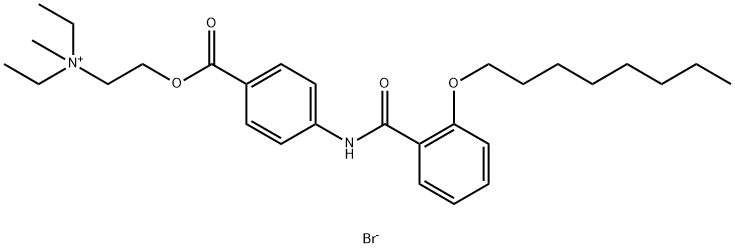Otilonium Bromide , ≥98% , 26095-59-0
Synonym(s):
N,N-Diethyl-N-methyl-2-[(4-{[2-(octyloxy)benzoyl]amino}benzoyl)oxy]ethanaminium bromide;N,N-Diethyl-N-methyl-2-[[4-[[2-(octyloxy)benzoyl]amino]benzoyl]oxy]-ethanaminium bromide;Octylonium bromide
CAS NO.:26095-59-0
Empirical Formula: C29H43BrN2O4
Molecular Weight: 563.57
MDL number: MFCD00211142
EINECS: 247-457-4
| Pack Size | Price | Stock | Quantity |
| 5G | RMB202.40 | In Stock |
|
| 25G | RMB640.00 | In Stock |
|
| others | Enquire |
PRODUCT Properties
| Melting point: | 130-133°C |
| storage temp. | -20°C |
| solubility | DMSO (Slightly), Methanol (Slightly) |
| form | powder |
| color | white to beige |
| Water Solubility | H2O: 5mg/mL, clear (warmed) |
| CAS DataBase Reference | 26095-59-0(CAS DataBase Reference) |
Description and Uses
Otilonium is an inhibitor of L-type (IC50 = 2.3 μM) and T-type calcium channels (IC50s = 0.8, 1.1, and 0.4 μM for Cav3.1, Cav3.2, and Cav3.3, respectively). It is also an antagonist of muscarinic acetylcholine receptors (mAChRs; IC50s = 0.054, 0.4, 0.222, and 0.156 μM for M1, M2, M4, and M5 muscarinic receptors, respectively) and the platelet activating factor (PAF) receptor (IC50 = 0.0552 μM). Otilonium inhibits the inward calcium current in isolated rat colonic smooth muscle cells (EC50 = 885 nM), an effect that can be blocked by the L-type calcium channel inhibitor nifedipine . It inhibits contractions induced by the muscarinic acetylcholine receptor (mAChR) agonist methacholine in isolated circular muscle of the guinea pig proximal colon (IC50 = 3.7 μM). Otilonium (4 mg/kg) decreases fecal excretion and wet dog shakes and increases the tail withdrawal latency in the tail-flick test in a rat model of opioid withdrawal syndrome induced by morphine and naloxone.
Otilonium bromide is an antimuscarinic
Safety
| Symbol(GHS) |  GHS07 |
| Signal word | Warning |
| Hazard statements | H315-H319-H335 |
| Precautionary statements | P305+P351+P338 |
| Toxicity | LD50 in mice (mg/kg) 87.0 i.p. |




